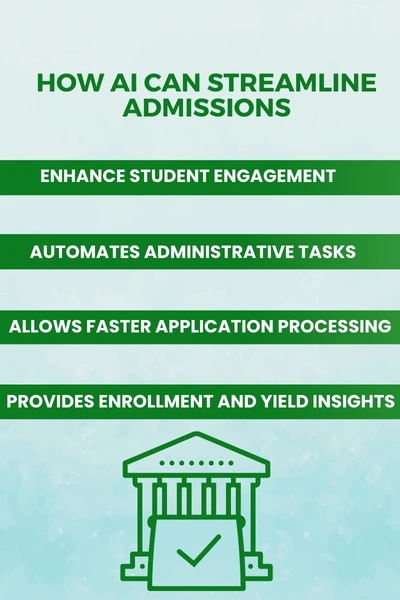Admissions offices in higher education are under more pressure than ever. In the 2023–2024 application cycle alone, over 9.47 million undergraduate applications were submitted through the Common App system to 1,074 member institutions. With application volumes soaring, tech-savvy students expecting seamless experiences, and growing demand for faster, data-driven decision-making, relying on manual, repetitive, and time-consuming processes is no longer sustainable. The need for modern solutions to streamline admissions has never been greater.
This is where Artificial Intelligence (AI) is stepping in to reshape admissions. By streamlining workflows, automating routine tasks, and offering predictive insights, AI is helping higher education institutions transform the way they attract, evaluate, and enroll students.
In this blog, we’ll explore how AI can streamline admissions processes and allow institutions to focus on what truly matters: enhancing student engagement and improving retention.
How AI is Streamlining Admissions:
- Enhancing Student Engagement
When prospective students face long response times or confusing application steps, it can create frustration and even deter them from applying. This is where Virtue Assist Smart AI Chatbot can transform the admissions experience. Unlike a static FAQ page, this tool offers real-time, personalized, and conversational support 24/7. It can instantly answer common questions, guide students through application requirements, and even explain the basics of financial aid. This not only improves the applicant’s journey but also frees admissions teams from repetitive inquiries, allowing them to focus on engaging students.
- Automating Repetitive Administrative Tasks
Manual data entry from documents like transcripts, award letters, and financial aid forms is a tedious, time-consuming, and error-prone task for admissions offices. AI-powered tools, such as Virtue File Reader (VFR), provide a solution by automatically converting typed, handwritten, or printed text into machine-readable formats. The tool intelligently categorizes key details like cost of attendance, scholarships, and student loans, enabling accurate comparisons for financial aid appeals and negotiations. By transforming unstructured documents into structured database entries, VFR helps institutions streamline workflows, reduce errors, and accelerate decision-making, ultimately making the review process much more efficient.
- Faster Application Processing
Reviewing applications is one of the most time-consuming aspects of admissions. Staff must verify documents, check eligibility, and track missing information, all of which can slow down the process. But AI-driven tools like The Counselor Report make this process more efficient by giving counselors a comprehensive view of each applicant’s progress, including recommendation letters, essays, test scores, and transcripts. By organizing student records in a structured format, the tool helps identify gaps, flag incomplete sections, and ensure timely follow-ups. It also enables admissions teams to collaborate with high school counselors through the portal, improving accuracy and boosting application completion rates.
- Predictive Enrollment and Yield Insights
Beyond processing applications, another challenge that institutions face is predicting which admitted students will actually enroll. Yield prediction is critical for planning class sizes, financial aid budgets, housing, and course availability. For this, data-driven predictive modeling tools like Acceptance Modeling and Weekly Projections Report provide deeper insights than traditional methods.
Using advanced algorithms, Acceptance Modeling helps admissions teams identify which applicants are most likely to accept offers and persist through graduation. The output not only predicts enrollment intent but also provides an SSI (Success Index) to guide targeted outreach and engagement strategies. Additionally, the model helps determine the optimal range of institutional aid that should be offered to maximize yield while maintaining budget efficiency.
Together with the Weekly Projections Report, which tracks enrollment patterns in real time, these predictive tools empower admissions teams and administrators to anticipate fluctuations, optimize resources, and remain agile in meeting the needs of their incoming class.
Embracing AI in Admissions
The adoption of AI in admissions is no longer a distant possibility, it’s happening now. Institutions that embrace AI are already seeing faster application processing, improved student engagement, and more accurate forecasting. By integrating AI-driven tools, colleges and universities can reduce administrative burden while creating a smoother, more student-centered admissions journey.
Ultimately, AI doesn’t replace the human element of admissions, it enhances it. Admissions professionals gain more time to focus on building relationships, supporting students, and shaping diverse, successful cohorts. By embracing AI today, institutions can position themselves for a future that is more efficient, equitable, and responsive to the evolving needs of students.
If you’re looking for a solution to streamline your admissions process, contact us today.
Source: 2023–2024 end-of-season first-year application trends (for applications data)


